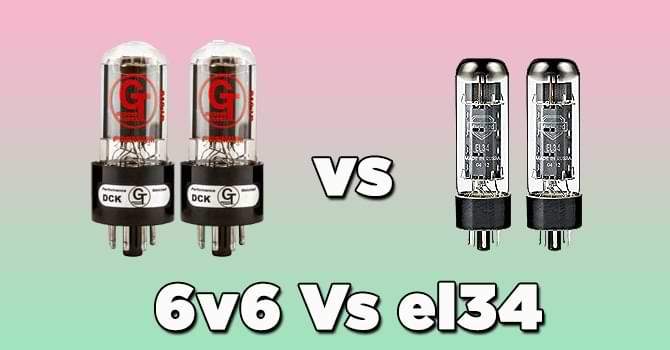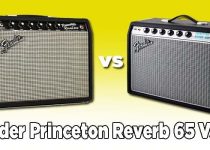6v6 Vs el34 [Difference & Which is better]
In the world of vacuum tubes, the debate between 6V6 vs EL34 tubes has raged on for decades. These two popular power tubes have their unique characteristics, making them beloved among audiophiles, musicians, and enthusiasts alike. From their historical origins to their sonic attributes, this article aims to delve into the intricate details of the 6V6 and EL34 tubes, providing a comprehensive comparison to help you determine which tube is better suited for your specific needs.

# Table of Contents =>
Historical Overview:
The 6V6 vacuum tube, developed by RCA in the late 1930s, was initially designed for use in consumer radios and audio equipment. Its small size and relatively low power output made it a popular choice for compact audio devices of the time. The 6V6’s design, featuring a glass envelope and four-pin base, was well-received due to its efficiency and affordability.
In contrast, the EL34 tube has a European origin, emerging in the 1950s. This tube was designed for higher power applications, including guitar amplifiers and audio equipment. The EL34’s distinctive pentode configuration and octal base set it apart from the 6V6. Known for its robust construction and higher wattage capabilities, the EL34 quickly gained popularity among musicians seeking amplified power and harmonically rich sound.
Sonic Characteristics:
The 6V6 tube is often associated with a warm and smooth tone. Its lower power output, typically ranging from 12 to 20 watts, contributes to a more subtle breakup when driven hard. This quality makes the 6V6 an excellent choice for vintage-style amplifiers, jazz enthusiasts, and those who value nuanced, articulate cleans even at higher volumes.
EL34 tubes, with their higher power output ranging from 25 to 50 watts. It is popular for their dynamic response and pronounced midrange presence. When pushed into distortion, EL34 tubes offer a distinctive harmonic saturation that’s beloved by rock and metal guitarists. The EL34’s ability to handle higher gain settings while maintaining clarity makes it an ideal choice for genres demanding both precision and power.
Amplifier Applications:
Amplifiers equipped with 6V6 tubes are often used in scenarios where a moderate power output is sufficient. Vintage-style amplifiers, blues, jazz, and smaller gigging setups benefit from the 6V6’s balanced tonality and smooth breakup. The inherent compression of the 6V6 also contributes to a “spongy” feel that many players find pleasing, making it suitable for touch-sensitive playing styles.
EL34 tubes find their home in high-power amplifiers favored by rock and metal musicians. These tubes provide a punchy low end, pronounced midrange, and a lively high end that cuts through mixes effortlessly. The EL34’s ability to handle high levels of gain without becoming overly compressed makes it a prime choice for genres requiring distortion while retaining note definition.
Comparative Analysis between the 6V6 vs EL34:
When comparing 6V6 and EL34 tubes, several factors come into play:
a) Power Output:

The most noticeable distinction is power output. The EL34’s higher wattage suits larger venues and genres demanding raw power, whereas the 6V6’s lower wattage offers a more controlled and intimate experience.
b) Tonal Characteristics:
The 6V6 leans toward warmth and smoothness, perfect for vintage tones and clean playing, while the EL34’s midrange focus and harmonic saturation cater to heavier styles and aggressive playing.
c) Genre Suitability:
The 6V6 finds its niche in jazz, blues, and classic rock settings, while the EL34 excels in hard rock, metal, and modern rock genres.
d) Dynamic Response:
The EL34’s dynamic range and response to picking nuances set it apart, offering a more expressive playing experience compared to the 6V6.
e) Amplifier Design:

The choice between 6V6 and EL34 tubes also affects amplifier circuit design. The tubes’ different power requirements necessitate varying transformer configurations and biasing adjustments.
Conclusion:
Ultimately, the decision between 6V6 and EL34 tubes comes down to your intended usage and tonal preferences. The 6V6 tube provides a mellower and more controlled tonal palette, suitable for vintage enthusiasts and players valuing clean tones with a touch of breakup. On the other hand, the EL34 tube is a powerhouse option that delivers a commanding presence, making it the go-to choice for those seeking the action distortion, punchy midrange, and a lively performance.
It’s worth noting that both tubes have stood the test of time and continue to find favor among musicians, audiophiles, and amplifier manufacturers. Each tube brings a unique sonic signature to the table, allowing you to sculpt your sound with precision and artistry.
In conclusion, there’s no definitive “better” tube between 6V6 vs EL34. Instead, both offer a distinct set of characteristics that cater to different musical styles and preferences. Whether you’re aiming for the warmth of the 6V6 or the power of the EL34, these tubes ensure that your sonic journey is as diverse as the music you create.
FAQs –
Q: What are 6V6 and EL34 tubes?
A: 6V6 and EL34 are types of vacuum tubes used in amplifiers and audio equipment. They have distinct characteristics that influence their tonal qualities and applications.
Q: Which genres are best suited for 6V6 tubes?
A: 6V6 tubes suited for genres such as jazz, blues, and classic rock. Their warm and clean tones, along with gentle breakup, complement these styles.
Q: Can EL34 tubes be used for clean tones?
A: While EL34 tubes are often associated with high-gain distortion, they can produce clean tones. However, their midrange-focused character might not offer the same clean clarity as 6V6 tubes.
Q: What is the advantage of 6V6 tubes in terms of amplifier design?
A: Amplifiers using 6V6 tubes built with smaller transformers and power supplies due to their lower wattage requirements. This makes them suitable for compact amplifiers.
Q: Which tube is better for recording purposes?
A: Both tubes have their merits in recording. 6V6 tubes might offer smoother, more controlled breakup at lower volumes, while EL34 tubes could provide a punchy and expressive midrange for dynamic recordings.
Q: Can I use 6V6 and EL34 tubes in the same amplifier for tonal versatility?
A: Some amplifiers offer the option to switch between different tube types, allowing you to explore a wider tonal range. However, always follow manufacturer guidelines and recommendations.
Q: How can I choose between 6V6 and EL34 tubes for my amplifier?
A: Consider your musical style, tonal preferences, and the amplifier’s intended use. If you value vintage warmth and cleaner tones, 6V6 might be your choice. For a powerful, midrange-focused, and aggressive sound, go for EL34 tubes.
Last Updated on September 10, 2023 by Perry Garner


